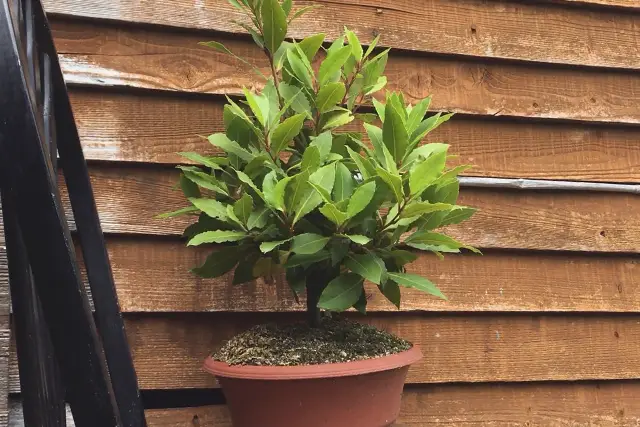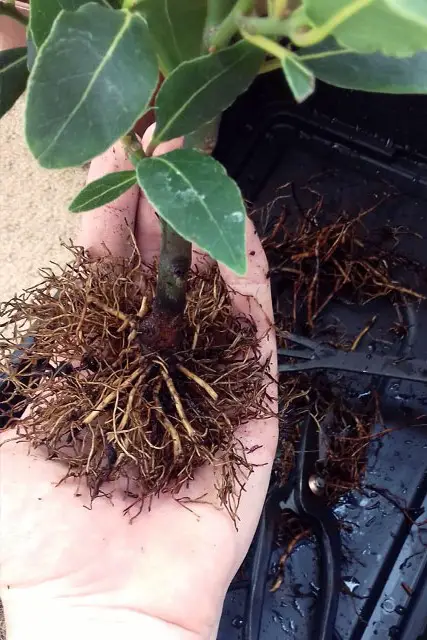The Bay Tree, also know as Laurus nobilis is a small evergreen shrub that is grown for its aromatic leaves that can be used in cooking. Yes, those bay leaves in your kitchen cupboard have just come off a tree that can also be grown as bonsai.
These trees are often used as topiary as you can get some quite dense foliage, which can be easily trimmed to shape and if one of the reasons why they can be great for bonsai.
I bought a small basic looking Bay tree in 2016 from a garden centre and I have been training it as a bonsai ever since, you can see how mine is developing here – My Bay Tree Bonsai Progression.

Page Contents
What Is The Natural Habitat of A Bay Tree ?
Knowing where a tree comes from can help us make sure we care for it properly. Bay trees are native to the Mediterranean area but they can happily grow in more northerly climates.
This means they like it warm and sunny, so give them as much of that as you can for best results, but its not essential. They are commonly found growing in gardens across the UK and the rest of Europe, both planted in the ground and potted up as topiary. This means they can cope with the rain and cold, but I will go through that more below.
What Soil Do Bay Tree Bonsai Need?
Bay bonsai prefer a moist, well draining soil. I use my standard mix of equal parts Perlite/Molar Clay/Compost and have never had any problems. So long as your soil is well draining it should be fine.
The fact that it is a Mediterranean tree, that is also happy to grow in places such as the UK shows it is pretty tolerant to a wide range of growing conditions and it will probably be able to handle less tolerable soil and you could use something with more organic matter in it, if you wanted to.
However, for optimum health you should try and plant them in good free draining bonsai soil as they will respond best to this.
(For more information on soil you can read – A General Guide To Bonsai Soil)
How Do You Water A Bay Tree Bonsai?
Bay bonsai enjoy plenty of water, but do not like to be waterlogged.
Being from the Mediterranean region they can probably get a little dry in between watering and survive, but I would not advise this. Always try and keep your soil slightly damp at all times and water it before it completely dries out.
Using well draining soil will make sure you can water it a lot, while also not waterlogging it. Soil and watering are always very closely linked. Good soil and good watering techniques will get you a a healthy tree.
(For more info you can read –How To Water A Bonsai)
How Much Sun Light Does A Bay Tree Bonsai Need?
Being a Mediterranean species, Bay trees can take full sun. The more light you can give them, they better they will grow. I have found that they can be quite slow to grow in the UK and this will probably be due to the lower light levels here.
Just try and position them somewhere that allows them to get plenty of light and that should be fine. You shouldn’t need any extra light, the sun should be enough. That is all I give mine.

How Hardy Are Bay Tree Bonsai?
Bay trees are hardy down to about -5°C/23°F when grown in the ground.
When grown in bonsai pots, they should not be allowed to get this cold. You need to remember that roots in pots are more likely to get damaged from the cold than when they are in the ground.
I would start to worry about them if the temperature drops below freezing for an extended period of time. In my area it only dips below for a few hours at a time and I have not had any problems with my tree.
They will need slight protection if the temperature is to drop below freezing for a while, You can do this by putting them in a shed until the extreme cold passes. I would not bring them inside to somewhere warm, they can stay cold, they just need protection from the extreme cold.
(For more info you can read – Working Out How To Over Winter Bonsai Trees)
How Often Do You Feed A Bay Tree Bonsai?
I feed my Bay bonsai once a month during the growing season with a general all purpose fertiliser. This should be more than enough to keep the tree healthy.
You do not need to go crazy with fertiliser, even if you are using a non-organic soil, less is often more. You also do not need to fertilise over the winter.
(For more info you can read – Do You Need To Use “Bonsai” Fertiliser?)
Repotting A Bay Tree Bonsai
As with nearly all trees, bay bonsai should be repotted in spring, just as the new buds are about to open.
I would also be cautious with the root pruning. I did take my bay back pretty hard, but it also sulked for a quite a while afterwards. I don’t think it really enjoyed the experience of having its roots hacked at, so you should not trim them back too aggressively. Take you time and develop the roots over a number of years.

I have also found I can usually get 2, maybe 3 years before I need to repot, but your own tree may vary and you need to look for the signs that it is ready to be repotted.
(You can read about that here- How To Repot A Bonsai Tree)
How Do Bay Tree Bonsai Respond to Pruning?
As bay is a herb, it responds very well to pruning. This is also why it is a popular choice for topiary. The growth can be long and course, but it will ramify and build up a lot of dense foliage fairly easily.
It will also back bud very well. You will need to check that there are not any back buds growing in crotches or where other branches are coming from. This can produce thick knuckles of growth if this is not removed.
If you are patient and give the tree time to grow, you can get some good results from pruning and you will be able to build up a decent structure for bonsai.
(For more info you can read- How To Prune A Bonsai Tree)
Wiring A Bay Tree Bonsai
Bay bonsai can be wired. They tend to grow very straight upright branches so wiring when young and flexible is ideal so that you get some interesting movement and shape into your tree.
They can be pruned to shape, which is why they are used as topiary, but do not be afraid to use wire. This can make getting your tree to the shape you want a lot easier and faster.
(For more info read – Why Do We Wire Bonsai?)
What Is The Leaf Pattern Of A Bay Tree Bonsai?
Bay Trees have opposite leaf patterns.

Bay trees are also evergreen, so the leaves will remain on the tree all year round. Occasionally some leaves may turn yellow and drop off, but this is nothing to worry about. It is just shedding old leaves.
What Pests Does A Bay Tree Bonsai Suffer From?
Leaf Spot is common in Bay trees, but this is normally due to being too wet, by managing water properly you can avoid this problem.
Other common pests can occur, such as scale and you may find the odd caterpillar on the leaves, but overall bay is fairly trouble free. I have never had any major issues with mine.
Can You Propagate A Bay Tree Bonsai?
Bay trees can be propagated easily from cuttings. they will root very easily if done correctly.
I have not heard of any one air layering a bay, but if they can root from cuttings, they should root for air layers. I have also never heard any one growing them from seed, but I guess this is possible. I have not had my tree flower (as I prune it) so I’m not sure how that works in regards to seeds.
What Is The Growth Rate Of A Bay Tree Bonsai?
I have found the growth rate of Bay bonsai to be quite slow. They seem to just sit there for a long time not doing anything. Then suddenly have a huge push of growth.
I believe it would grow a lot faster in its native, warmer climate. I think they need to absorb a certain amount of energy before they will grow. As I live in a pretty northern area, I think it takes a little time for it to reach the amount of energy it needs.
Just be patient, they will grow and if you live somewhere a little warmer, I imagine they will grow like crazy for you.
Can You Eat Your Bonsai Bay Leaves
You can use the leaves from your bay bonsai in cooking, either fresh or dried. Just because you are training it as a bonsai does not change the fact that this is a herb plant that is safe to eat.
If you are going to do this, make sure you haven’t sprayed the tree with pesticides (and most fertilisers too). You really do not want to eat that stuff! and of course make sure you actually have a bay tree, you don’t want to be eating some other species.
Should You Get A Bay Tree Bonsai?
Bay trees are easily cared for, but they are not ideal trees for bonsai beginners. They are going to require a little more work that some other trees to get them to the shape you want.
If you want just a general garden plant, or topiary, then they are perfect for a beginner.
They are just not great for bonsai. They have large leaves that do not reduce well and their growth can be long, straight and inflexible, making it difficult to style. You would also never be able to have a very small tree due to their growth habits. You will always end up with a larger style bonsai.
They are quite the challenge, even though they are very easy to care for. You can read about my experience and opinion on them here – Do Bay Trees Make Good Bonsai?

Hi, I’m Ian. I have been doing bonsai since 2014. I created this site to spread all the knowledge I have acquired over the years. Don’t forget to check out my Youtube videos where I show the progress of my own Bonsai each week or connect with me on social media.
You can read more about me and how I got into Bonsai on the About Page


